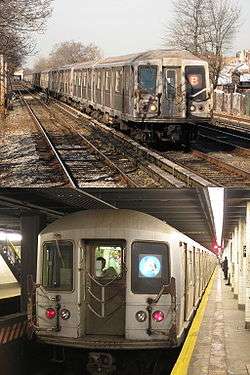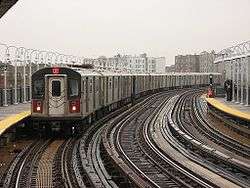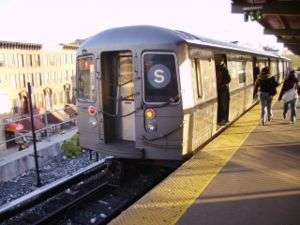R40A (New York City Subway car)
| R40A | |
|---|---|
|
Slant-ended R40A (above) and straight-ended R40A (below). | |
|
Interior of a straight-ended R40A car. | |
| Manufacturer | St. Louis Car Company |
| Replaced | many BMT AB Standards |
| Constructed | 1968–1969 |
| Refurbishment | 1988–1989 |
| Scrapped | 2008-2010, 2013 |
| Number built | 200 (100 slant end & 100 straight end) |
| Number preserved | 4 |
| Number scrapped | 196 |
| Formation | Married Pairs |
| Fleet numbers |
4350-4449 (slant-ended) 4450-4549 (straight-ended) (see article for details) |
| Capacity | 44 (seated) |
| Operator(s) | New York City Subway |
| Specifications | |
| Car body construction | Stainless Steel sides with Carbon Steel chassis and underframes, Fiberglass A-end bonnet |
| Car length | 60 ft (18.29 m) |
| Width | 10 ft (3.05 m) |
| Height | 12.08 ft (3.7 m) |
| Platform height | 3.76 ft (1.15 m) |
| Doors | 8 |
| Maximum speed | 55 mph (89 km/h) |
| Weight |
77,695 lb (35,242 kg) (slant) 78,030 lb (35,394 kg) |
| Traction system | General Electric (GE) SCM 17KG192AE2 propulsion system using GE 1257E1 motors (115 hp or 86 kW per axle) |
| Braking system(s) | WABCO "SMEE" Braking System, A.S.F. simplex unit cylinder clasp (tread) brake |
| Safety system(s) | emergency brakes |
| Track gauge | 4 ft 8 1⁄2 in (1,435 mm) |
The R40A was a New York City Subway car model built from 1968 to 1969 by the St. Louis Car Company in Missouri for the IND/BMT B Division. The order was a continuation of the R40 cars, and contained two forms or body types: a slant-ended version identical to the original R40 fleet (nicknamed the R40 Slant or R40S), and a straight-ended (or "modified") version designed by Sundberg-Ferar (nicknamed the R40M).
Description
The slant-ended R40As were originally numbered 4450-4549, and the straight-ended R40As were originally numbered 4250-4349; these cars were later renumbered to 4350-4449 and 4450-4549 respectively.
The R40As were delivered new with the same successful Stone Safety 10 ton air conditioning systems/units found on the last ten R38 cars, and became standard equipment on all future new cars purchased from this point onward. As a result of the air conditioning, the standee poles were arranged in an alternating pattern rather than the straight-line pattern seen in the older R40s.
History
Due to the cosmetic and mechanical similarities the straight-ended R40As and the R42s shared, the two fleets often ran together. In fact, one pair of cars consisted of a R40A car mated to a R42 car. This was the result of an accident on the Williamsburg Bridge in 1995, which involved R40As 4460-4461 and R42s 4664-4665. R42 4664 was written off while R40A 4461 was repaired and rebuilt into a slant-ended car (and temporarily numbered 4260),[1][2] leaving R40A 4460 and R42 4665 to become paired to each other.
In 1988–1989, the R40As were rebuilt by Sumitomo in Elmira Heights, New York. The interior was changed drastically and the MTA paint band was removed in all rebuilt cars.
Retirement and preservation
The R160 subway car order replaced all of the R40A fleet from 2007 to 2009. The slant-ended R40As were retired and reefed first, from late 2007 to June 12, 2009, when the last slant-ended train, consisting of R40A pairs 4414–4415, 4424–4425, 4432–4433, 4398–4399, and R40 4256–4257, made its final trip on the A. The straight-ended R40As were retired starting in January 2009 until August 28, 2009, when the last straight-ended pair, 4484–4485, ran on the V along with four R42 pairs.
After retirement, most cars were stripped and sunk as artificial reefs along the Atlantic coast. The last R40A cars to be removed from property by barge were straight-ended cars 4474-4475, which were reefed in April 2010. However, slant-ended pairs 4392-4393 and 4442-4443 were retained as school cars until April 2013 and October 2013, respectively. The cars were taken to Sims Metal Management to be scrapped, as the reefing program had ended in April 2010.[3][4]
While all slant-ended R40As were removed from property, some straight-ended R40As have been preserved, including:
- 4460 (and its R42 mate 4665), preserved by the Railway Preservation Corporation and stored at Coney Island Yard.
- 4461, currently at the Randall's Island FDNY Facility, used with R62s 1366 and 1370 as training cars.[5][6]
- 4480–4481, preserved by the New York Transit Museum and currently stored at the Concourse Yard. The cars are in need of restoration.[7]
See Also
- R40 (New York City Subway car) - The slanted cars were similar to this model built by St. Louis Car company.
- R42 (New York City Subway car) - A model similar to the straight-ended R40As, built by St. Louis Car Company.
Further reading
- Sansone, Gene. Evolution of New York City subways: An illustrated history of New York City's transit cars, 1867-1997. New York Transit Museum Press, New York, 1997 ISBN 978-0-9637492-8-4
References
- ↑ http://www.nycsubway.org/perl/show?5330
- ↑ http://www.nycsubway.org/perl/show?31752
- ↑ Parke, Phoebe (February 26, 2015). "Dumping subway trains into the ocean ... in a good way". CNN. Retrieved February 6, 2016.
- ↑ "For Subway Cars, the Final Trip". New York Times. May 15, 2011. Retrieved February 6, 2016.
- ↑ http://www.rrpicturearchives.net/showPicture.aspx?id=674173
- ↑ http://subhysteria.wordpress.com/tag/scout/
- ↑




